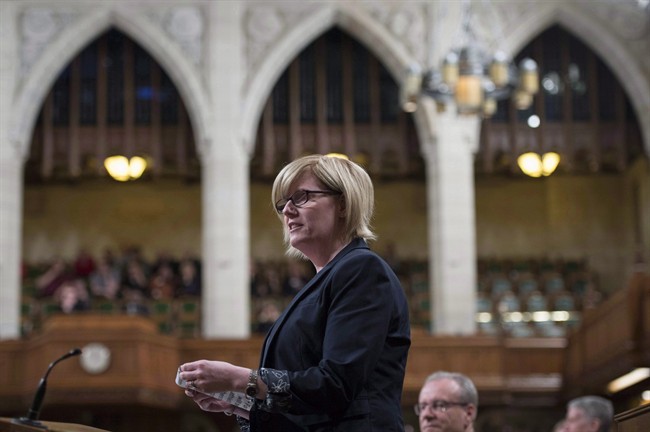TORONTO – Public consultations on Canada’s first national law for disabled people have identified high unemployment rates, inaccessible buildings and barriers in transportation as some of the key issues that need to be addressed.

The priorities were laid out in a report, released by the federal government Monday, summarizing eight months of consultations held with Canadians from coast to coast.
It says participants wanted to see laws that would help lower stubbornly high unemployment rates for those with disabilities, reduce the number of buildings inaccessible to those with physical and intellectual disabilities, and remove accessibility barriers for the country’s air, rail, ferry and bus transportation systems.
READ MORE: Federal government reviewing policy that bars passport offices from helping disabled applicants
Those consulted also named government program and service delivery, information and communications and procurement of goods and services as key areas of focus.
The report also says Canadians have voiced a strong preference for the government to set up an independent body to oversee compliance with the new laws, which are expected to come before the House of Commons in early 2018.
Minister for Sport and Persons with Disabilities Carla Qualtrough said the consultations have laid the groundwork for her to begin crafting the legislation.
“It’s definitely marching orders for me in terms of what Canadians want to see in accessibility legislation,” Qualtrough said in an interview.
“My goal now is to figure out how we write into law these concepts and these principles and these specific ideas.”
The prospective act, which disability rights advocates have been seeking for years, would govern areas that fall under federal jurisdiction, such as banks, telecommunications, and interprovincial transportation.
The report currently estimates one in seven Canadians has some form of disability and projects that number will increase as the population ages.

Get breaking National news
Those are not confined to visible conditions such as blindness or paralysis, but include mental health disorders, learning disabilities, and episodic ailments such as epilepsy and multiple sclerosis.
The sweeping new legislation will attempt to eliminate barriers for this growing demographic, taking an equally broad view of what a barrier entails.
READ MORE: Blind woman highlights need for better access after Passport Canada did not help her fill out form
“My definition of ‘barrier’ is anything that impairs or prevents access, physically or mentally, to any physical movement, learning and/or acceptance by others,” the report quotes one contributor as saying. “Ergo, ‘accessibility’ successfully counters or eliminates the barriers.”
The report said 6,000 Canadians participated in the consultations between June 2016 and February 2017. An additional 90 organizations also offered input.
- Alberta family navigates vacation death nightmare: ‘Basically stuck there’
- Nearly 30 years later, is Quebec headed for another independence referendum?
- 4 new measles cases in Quebec outbreak, experts warn of possible exposure
- Wrestling legend Sweet Daddy Siki remembered across Canada for his greatness
Employment issues were the top priority identified by the report.
Data has long shown that Canadians with disabilities are greatly under-employed compared to their non-disabled counterparts. Two years ago, Statistics Canada released figures putting the employment rate for disabled Canadians at 49 per cent, compared to 79 per cent for the general population.
READ MORE: Toronto woman launches human rights complaint over washroom access issue
Qualtrough noted that many smaller issues are also contained within the broad categories highlighted by the report, citing immigration as an example.
Current legislation effectively bars many people with disabilities from securing long-term status in the country, and Qualtrough said the government is looking to make changes. Such efforts, she said, would fall under the umbrella of programs and services.
So could policies such as those in place at Passport Canada, which currently forbid staff from helping a person with a disability complete their forms.
Transportation regulations could help address situations such as one that arose at Via Rail and culminated in a federal agency ruling that the company had to allow more than one mobility device at a time to be tied down on its trains.
READ MORE: Ontario family’s lawsuit alleges people with developmental disabilities denied necessary services
Advocates, however, are hoping the government’s plans become more concrete as the legislation takes shape.
James Hicks, National Co-ordinator of the Council of Canadians with Disabilities, said the consultations were more an airing of grievances than a forum for tabling ideas on how to bring about change.
He said the process was important, but hoped the legislation will go beyond aspirational statements.
To that end, the council is joining other community-based groups that will continue soliciting feedback from Canadians. Hicks said the government is paying for the additional feedback and will hopefully put it to good use.
READ MORE: Canadians with Disabilities Act to focus on employment: minister
He said one suggestion the government will hear involves forcing provinces to consider disability issues when applying for federal funds.
He said all proposals submitted to cabinet today must include a gender analysis to account for the impact on women, adding he’d like to see the new law require something similar for the disabled.
“Why is there not a disability lens that has to be done on every single request for funding that goes to cabinet?” he said. “That way every department has to look at it and has to say ‘this is what we need to do to ensure equal access for people with disabilities.”
Qualtrough said the report was firm on one concrete measure – once the law is in place, an independent body must be set up to ensure people are complying with it.
READ MORE: Half of Canadians living with disabilities don’t have a job: poll
Currently, discrimination complaints come before provincial or federal human rights commissions only after an offence has taken place.
“We shouldn’t have to wait until someone’s discriminated against to help them,” Qualtrough said. “It’s not enough. Loud and clear I heard that it’s not enough.”







Comments